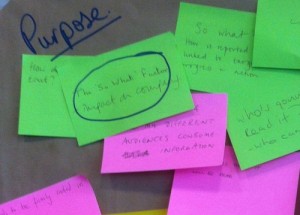Last Thursday I had the pleasure of co-hosting my second Oomph seminar with brothers Dan and Ben Vivian; collectively the Vivian Partnership. Oomph seminars are interactive lunch time sessions to bring together professionals that don’t normally talk to one another to create new ideas and ways to give sustainability some renewed energy… The philosophy of Oomph is simple; get excited, shake up ideas and give it some oomph. They are also a lot of fun – even if you do find yourself being tricked into wearing ridiculous accessories every now and again.
If you have a project you would like to share with our community, an event you would like to host or an idea you would like to blog about then we would love to hear from you. Please email me at louisa.harris@6-heads.com for more information.
The So What Factor – Guest blog by the Vivian Partnership
Yesterday’s third Oomph Seminar of 2014, entitled how to make sustainability reporting matter was a great success and prompted much discussion and a flood of ideas to excite. Hosted in the ‘penthouse’ of Grant Thornton’s Finsbury Square headquarters, the Indian Summer sunshine clearly stimulated the grey matter of everyone. As is the modus operandi of Oomph, everyone contributed and the brown paper covering the walls was crammed with thoughts on what makes sustainability reporting matter from one of two perspectives – the writer and the reader. By taking opposing perspectives we explored the key areas of overlap.
There were some great challenging ideas presented to set the scene, the one that seemed to hit home hardest was some research from the US that Dan Vivian had uncovered which showed that CSR reporting (as it is more commonly called over there) shows the lowest return on investment (ROI) of any marketing collateral.
“Despite the considerable efforts that corporations put into reporting their social and environmental performance, readership is low and believability is even lower.” from the article. The fact that many organisations do not consider their sustainability report as a part of their marketing portfolio may be the root cause behind this finding.
The “so what?” factor came out as a common issue for both readers and writers. This is a key part of making reporting matter for both sides. “So what?” becomes a key question. Employees often say “so what?” as their everyday experiences are not reflected in the language and stories in their employers’ reporting. The salesforce have not had a role in determining the “so what?” and how it might contribute positively to their conversations with customers / consumers.
Often external stakeholders ask “so what?” because the reporting is so remote from their interests in the company. Local residents of an industrial plant are not really interested in the total emissions from a global multinational, and trying to impress them with carbon reduction success when their experience is at odds leads to a disconnect from which it takes time to recover. Answering the “So what?” question can be crucial in setting the value the report and it seems this value is rather low (or more likely it is unknown) at the moment.
As many consumer facing companies have learned through the growth of websites like TripAdvisor, it can be much more powerful for those outside the company to have their say. Many sustainability reports contain comments and quotes from others outside the corporate clique, some even have a formal external panel which has some sway in the direction. Both are good moves but there is still a reluctance to let go of the reins.
Please don’t misinterpret this as meaning we do not need data or assurance. We do and it is the basis of the process, for without it basic credibility is impossible to achieve. But sustainability reporting shouldn’t be all about the data – otherwise the “so what?” factor will remain and trust will continue to decline.
The fundamental issue in making sustainability reporting matter – both internally and externally – is to address the “so what?” factor. Addressing this will identify what people want and need to know and how this experience will affect their perception of the company, its products and overall brand promise. In turn this will begin to bring about change through the combination of stories and data. But fundamental to successful reporting would then be to take all your corporate courage in your hands and get your employees or other stakeholders to prepare their own for you. Oh and please (and this is a personal plea I shared at the end of the session) stop calling it a report or using the term reporting. Give it an identity with which the readership can truly engage.
– See more at: http://www.vivianpartnership.co.uk/the-so-what-factor/#sthash.uov9NUgz.dpuf

